Living and Learning
This week, our Living and Learning statement is I recognise emotions in myself and others. Yesterday, we had fun looking in the mirror and acting out different emotions with our friends. We thought about what happens to our face when we experience different emotions. 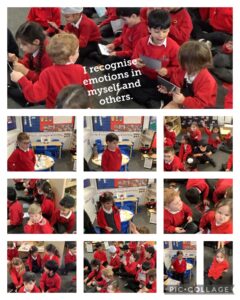
What happens when you do an angry face?
Rowan – Your teeth go sideways.
Rayaan – It looks like a monster.
Jasmine – I know it’s angry because she’s got eyes down and straight lips.
What happens when you do a worried face?
Zara – Your bottom lip comes out.
Teddy – Sometimes your lips can go together.
We also thought about what we can do if we see someone looking sad.
Zara – Ask if they are okay.
Teddy – If someone’s looking upset, you could say sorry.
Bryher – You could ask them to play with you.
Help at home: Talk to your child about their emotions . You could play a game of Guess my emotion by acting them out together.
Living & Learning – I recognise emotions
This week, we welcomed a visitor from Kooth to talk to us about mental health and emotions.
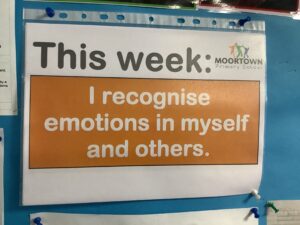
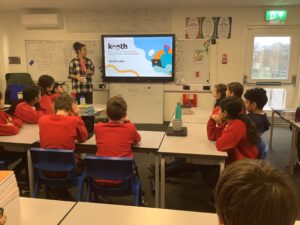
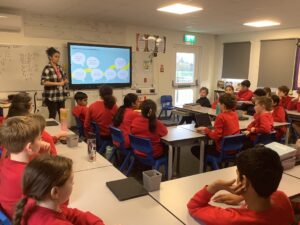
Kooth is a free website approved by the NHS to support young people with mental health used by over 1.5million children nationwide. It’s anonymous and full of self-help tools, mini activities and discussion boards to get the assistance you need. The best thing about it is that every post or comment is approved before it’s live so it’s a totally positive zone.
Help at home by exploring the website and having a discussion about your mental health triggers – what makes you feel both bad or good?
Here are some key messages from this week’s living and learning:
- it’s ok to ask for help
- keep active
- focus on what you’re good at
- find helpful, practical ways to express and manage your emotions
Science and PE: What is physical activity?
This week, Year 5 were joined by some visitors from the University of Leeds. They came in to talk to us about maintaining a healthy lifestyle. By the end of the lesson the children were able to define what physical activity is, explain why exercise is good for you and understand the difference between a warm-up and cool-down.

Aerobic exercise is a type of activity that makes your heart beat faster and makes you breathe a little harder.
Anaerobic exercises are quick and intense activities that use energy stored in muscles, not relying much on oxygen. This includes movements like:
- Sprinting
- Jumping
- Lifting heavy weights

Our visitors will be back next week to talk to us about healthy eating and nutrition.
Help at home: Discuss how often we should be active every day and how we can live more active lifestyles.
Times tables rock stars
Welcome back!
This week, all children will be receiving their login details for Times Tables Rock Stars. These are the same logins as for Numbots.

In Year 2, the children learn the two, five and ten times tables and these are the tables that have been assigned to the children. There will be division questions related to those times tables too.
Soundcheck is used in Key Stage 2 to check all the times table facts up to x12 so this isn’t recommended in Year 2 as the children haven’t learned these other times tables yet.
We encourage the children to continue to use Numbots too to help to secure their addition and subtraction number facts.
Another resource to support times tables and other number facts is Hit the Button. This is a great, fast-paced game and children can choose which times tables or number facts to work on during each game. This game is free to play online.
If you have any further questions regarding the resources mentioned, do not hesitate to contact us.
Living and Learning – Being safe
Hello!
Being safe is a key part of our Living and Learning curriculum including a Staying Safe themed week coming up next term in July.
Year 3 learnt about being safe around the concept of consent (giving and receiving permission).
We realised that ask for permission to do things quite a lot… especially at school! Please may I go to the toilet? Please can I get a tissue? Can I have some help?
We discussed how asking for consent or permission is important in other scenarios too! For example, asking to be in a group with a friend, asking a friend for a hug or asking consent to take a photo of a someone.
In this learning, we had some different permission scenarios to decide whether they would need to ask for permission or not.
Bob would like to play his brother’s game. Bob should ask his brother for permission as the game doesn’t belong to him!
Sasha wants to go for a sleepover at her best friends’s house next weekend. It depends how old she is but she needs to ask a grown up for permission so they know where she is and that she’s safe!
Help at home and discuss this scenario with your child:
Alex would like to go to the park with his friends.
Does Alex need to ask for permission? Why?
Who could he ask?
How could he ask?
We also thought about which grown-ups would be good to talk to in school and out of school (start telling other people) if we ever feel unsafe. Brothers, sisters and friends would also be good to talk to and discuss feelings but telling a grown-up (over 18) would be the best thing to do to get help.
Spring 1: Week 5
This week, we’ve been learning all about the Lunar New Year. Our focus story was The Magic Paintbrush by Julia Donaldson. We used our imaginations to think about what we would paint if we were given a magic paintbrush.
Teddy – I would paint a Ferrari.
Gurjeevan – I would paint a Lamborghini.
Bryher – I would paint a princess.
Gurshaan – I would paint rainbow water.
Ivy – I would paint a unicorn.
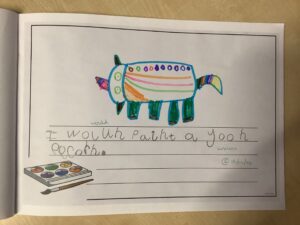
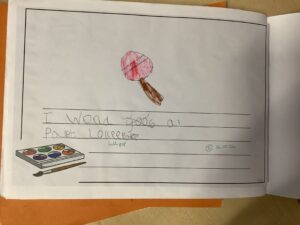
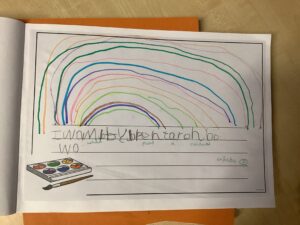
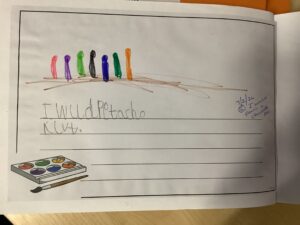
On Wednesday, we watched a video about how people prepare and celebrate the Lunar New Year.
Ayah – They clean and decorate their house.
Edie – They cook nice food.
Yesterday, we read The Great Race and learnt about how the Chinese Zodiac started. We had a go at putting the animals in order.
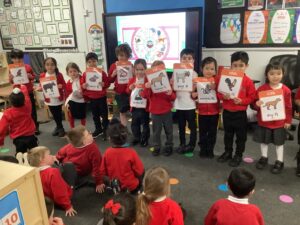
Help at home: Can you remember to order of the Zodiac animals? You could draw a picture or write them in a list.
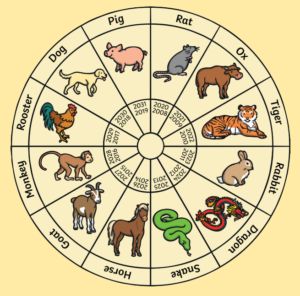 Here are some of this week’s chilli challenges in action…
Here are some of this week’s chilli challenges in action…
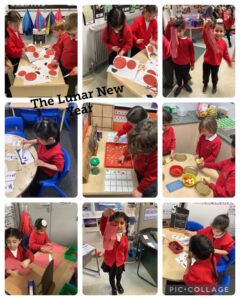
Finally, thank you to all who attended the parent-teacher meetings this week. It was lovely to talk about the children’s learning and their fantastic progress.
As always, I hope you all have a happy and healthy half-term break. Don’t forget to KEEP READING and send me an email of what you get up to. I look forward to seeing you all again on Monday 19 February.
Living and Learning: Safer Internet Day
This week, it was Safer Internet Day and we spent the day focusing on these two key areas of online safety.
- I know that some things online may not be true (people and information).
- I know that I shouldn’t share personal information online.
We read Chicken Clicking, a cautionary tale about a chicken not using the internet safely. We thought about how Chicken Clicking could have done things differently and what advice we would give him to keep him safe.
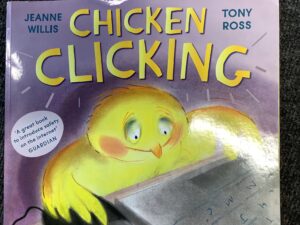
This video also reinforced key messages about sharing personal information online like your password, name, age or address.
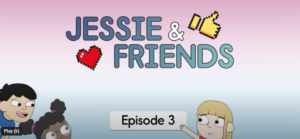
Throughout this learning, we reinforced the message that if the children were unsure or something didn’t feel right they should always Start Telling Other People and let a trusted adult know.
We talked through this sequence of seeking help.
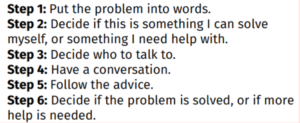
Help at home: Can your child tell you the key messages from the texts we read?
Also, our online safety section has further support available for parents.
Reading refresh!
Every half term we have a refresh of the books in our reading corner. The children are given time to look through and browse the books on their table. After they have had a chance to look through them all they choose one to put in the the box. It was so lovely to see how engaged the children were with the new books and how much they love stories! We had time to read a couple of the new stories too. I can’t wait to read more of them when we come back after half term.
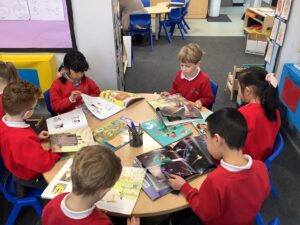
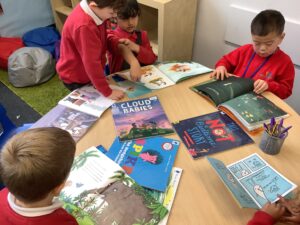 !
!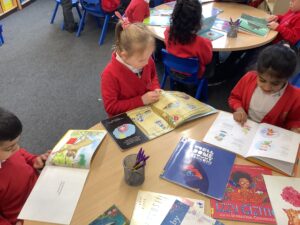
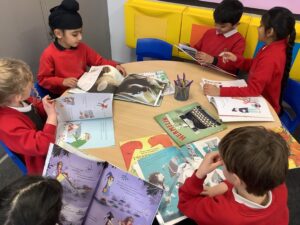
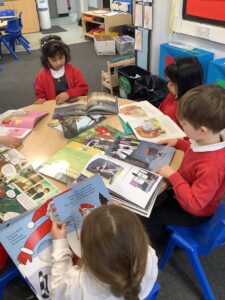
Help at home by reading the books your child brings home from the library or visiting the library over the half term
Living and Learning: Safer Internet Day
This week, it was Safer Internet Day and we spent the day focusing on these two key areas of online safety.
- I know that some things online may not be true (people and information).
- I know that I shouldn’t share personal information online.
We used a few different texts to support this learning and our daily poem too.

Hot seating the characters helped to think about their feelings and actions.
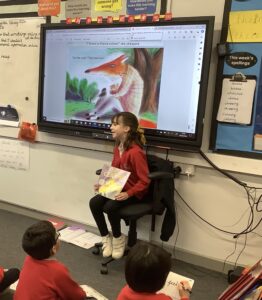
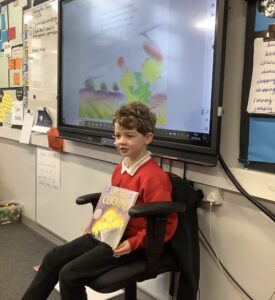
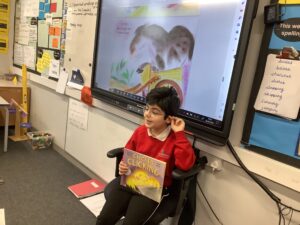
This video also reinforced key messages about not everything online is true (this could be people or information) and the importance of not sharing any of your personal information.

Throughout this learning, we reinforced the message that if the children were unsure or something didn’t feel right they should always Start Telling Other People and let a trusted adult know.
We talked through this sequence of seeking help.

Help at home: Can your child tell you the key messages from the texts we read?
Also, our online safety section has further support available for parents.
Living and Learning: Safer internet day
On Tuesday 6th February, we celebrated safer internet day. It was a chance to think about any worries we might have about using technology and the internet, but it’s also about celebrating all the fantastic things technology can help us with.
In one of our lessons, we discussed why it’s important to check with a trusted adult before sharing personal information online. Personal information is any information that is about who you are and what you do.
Websites and apps can collect our personal information and data and use it to provide services to us.
We need to keep this information safe whilst online and not give it to just anyone! We must always speak to a trusted adult before sharing any information online.
In another lesson, we focused on how to have a healthy balance of online and offline activity. The children were able to give lots of different activities to do whilst being offline:
- playing outside
- arts and crafts
- reading a book
- spend time with family
Help at home: Discuss how to help Greg, Jess, Brian and Haya in these scenarios.
